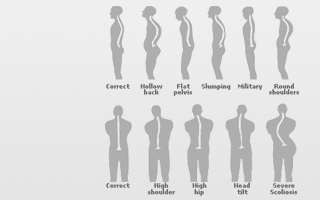This article is written by Dr. Steven Cannon, Chiropractor at Neurohealth Chiropractic Allambie (Northern Beaches, Manly)
The human body when upright is constantly put under a downward pressure towards the ground. This pressure is called Gravity and it compresses the human body on a daily basis. Have you ever had to adjust your rearview mirror in the morning and thought who has been in the car? This is due to gravity and the rehydration of the spinal discs over night as you have slept. We are on average 1-3cm taller, depending on age, in the morning than the evening due to this gravity. Over a lifetime, a person can permanently lose between 1–5cm in height due to the loss of disc height.
Posture is an unconscious position that is assumed by the body in response to this gravity force. The genes we inherit can influence it, but most likely it is affected by the way we use our body during regular activities such as standing, sitting and sleeping.
Hence, with all the strain that is put on our body from gravity and living our daily lifestyles, we get lazy and start to slouch. As children we have great posture, all those years of tummy time and learning how to crawl, then walk activated our postural muscles and our core muscles to help maintain posture and good spinal alignment.
Then we sit at desks, use computers, watch televisions, and slouch on the couch. Now with the introduction of smart phones, iPad’s, and tablets we are craning our neck forward even further to view these devices and affecting our posture. There is even a new diagnosis that is appearing in the literature called ‘text neck’ which is the posture that we adopt when using our mobile phones or other portable devices.
In Kapandji’s book the Physiology of Joints Vol. 3 (2008), he showed that for every 2cm that your neck moves forward, the weight on your neck and shoulders doubles. The average weight of an adult human head is 5kg, constituting around 8% of the whole body mass. Therefore if you head moves forward 6cm, the mass of your head on your shoulders would be 20kg.
Poor posture, affects the overall health of your body. Slouching in the shoulders causes, crowding of the lungs and heart, therefore putting unduly stress on the cardiorespiratory system of the body. It reduces lung volume and hinders the diaphragmatic movement; thereby decreasing the amount of air taken into the lungs and requiring the heart to work harder to pump blood, which in turn, creates congestion in the lungs and back pressure on the circulation of blood around the body, leading to swelling in the pelvis and legs.
Poor posture puts additional strain on the muscles, ligaments and discs of the back. Over time this strain causes structural deformation to this ligaments and muscle imbalances from front to back and left to right. These structural changes are what can cause mild to moderate back pain.
If left uncorrected and the muscle imbalances let to engrain into the body’s movements, we increase and place unnecessary strain through the body, leading to early osteoarthritis, degeneration and the body just wearing out more quickly than it should.
It is evident then, why so many of us suffer from aches, pains, headaches and other medical problems which we blame on ‘just getting older’. When in fact, if we looked at our posture, this can be an indicator of age than years. Good posture is achieved by correcting the internal strains that are the causes of many problems.
For example, those who spend all their day hunched over a desk and/or computer often develops shortened, tight chest muscles and weak, lengthened back muscles.
Good posture begins with the feet. If the feet are not stable and the arches of them are dropped or collapsed such as in over-pronation, then the body will start to make subtle changes to accommodate this. i.e if your foundations of your building are unstable then all the cracks appear in the ceiling. If you just fix the cracks and not the foundations, the cracks will just reappear and you have not got to the cause of the problem.Foot levelers link
Therefore if your foot rolls in, the knee will twist, the hips rotate, and it will lead to a torsional force up through the spine, twisting and turning to try and get the eyes parallel with the horizon.
So what is good posture? We should naturally have 3 curves throughout our spine; 2 lordotic curves (cervical and lumbar), and our primary curve that we are born with, the thoracic kyphosis. These curves help to transmit forces and act like shock absorbers in our spine. A neutral spine is what constitutes ideal posture. The key features of an ideal spine are:
- The head should be held up straight, with the chin tucked. Earlobes are level and over your shoulders.
- Your shoulders should be in line with your hips. You can achieve this by lifting your sternum and imaging that you have string on your sternum, pulling it towards the ceiling. This should result in the shoulders coming back.
- Your thumbs need to be facing forward and not touching our thighs. If they touch your thigh, this will internally rotate your shoulders and lead to unnecessary neck and upper back pain.
- Maintain a slight hollow in the lower back, to maintain the natural curve in the lumbar spine, but the buttock shouldn’t lift as this will just accentuate the lower portion of the curve
- The hips should be level.
- If sitting, your feet should be flat on the ground, and for males the wallet should be out of the back pocket.
How can I improve my posture?
Posture is an unconscious response to your environment. Therefore you need to make a concerted effort to make changes. Anytime you think of it, try and stand/sit up straight. Other things you need to do is:
- Stand with your back and heels against a wall. Have your low back flat against the wall. Hold that position for 30-60 seconds and then try and walk away from the wall and maintain your position.
- Strengthen muscles that are weak, especially mid thoracic/back muscles such as the rhomboids, lower trapezius, and the serratus posterior. The scapular retraction muscles.
- Stretch tight muscles. These muscles are normally the muscles on the anterior/front of body. The pectorals muscles and the hip flexors.
- Strengthen the core muscles. These exercises target your transverse abdominis, and multifidi which can help lift and maintain correct spinal alignment.
- Use of a foam roller to release muscles and also to help passively stretch tight shoulders and chest muscles.
Simply by analyzing and measuring a person’s posture and then correcting the distortions found with chiropractic adjustments, muscle rehabilitation and balancing, we can remove the internal strains on the body, therefore arresting the degeneration of health, even before symptoms can appear.
If you have any questions or would like to further discuss the above information, contact the team at Neurohealth Chiropractic.




